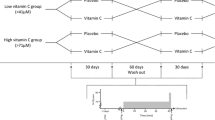Summary
The effect of vitamin C administration on the mechanical efficiency has been studied in test persons.
The double-blind method was applied, according to which vitamin C (for 5 days 1 g m per day in the form of Redoxon effervescent tablets) was administered to some of the test persons, and placebo tablets to some others, the distribution being unknown to the test persons and the investigators. Only after termination of the investigation were the investigators told which test persons had been given vitamin C and who had taken placebo tablets.
The values of the vitamin C content found in the blood indicated that before vitamin C administration (and before placebo administration) the organism of the test persons was not saturated with vitamin C. After C-vitaminization a state of saturation was found to exist (see Table 1).
The effects of this adequate C-vitaminization (i. e. by which saturation is realized) were found to be a decrease in excess metabolism of exercise and an increase in mechanical efficiency. The average increase in efficiency was about 10%.
Previous investigations (Hoitink) had shnow that an adequate C-vitaminization increases the working capacity and that in some respects there is a resemblance between the conditions of training and of adequate C-vitaminization, both conditions being accompanied by a corresponding complex of effects. This complex can now be extended by the noteworthy effect of efficiency increase, so that this resemblance forces itself upon us with all the more reason.
Our investigation leads to the conclusion that the adequate C-vitaminization improves the working economy of the organism (clearly manifested by an increase in mechanical efficiency) and renders the organism better suitable for performing work (resemblance between C-vitaminization and training effects.
The increase in working capacity by an adequate C-vitaminization found in a former investigation, is in agreement with this finding.
Similar content being viewed by others
References
Engel, C. in E. C.Noyons: Chemie en Kliniek3, 242 (1952).
Enschedé, F. A. J.: Over de training van schaatsenrijders. Thesis, Utrecht (1960).
Hoitink, A. W. J. H.: (1) Vitamine C en Arbeid. Onderzoekingen over de invloed van arbeid en van vitamine C-toediening op het menselijk organisme (Vitamine C and Work. Researches on the influence of work and of vitamine C administration on the human organism. Nederl. Inst. v. Prevent. Geneesk., Leiden 1946 (With summary in English).
—: Researches on the influence of vitamin C administration on the human organism, in particular in connection with the working capacity. Acta brev. neerl. Physiol.14, 62 (1946).
Lanooy, C., andE. H. Bonjer: A hyperbolic ergometer for cycling and cranking, J. appl. Physiol.9, 499 (1956).
Noyons, A. K. M.: Eine Methode zur kontinuierlichen Registrierung des Stoffwechsels von Mensch und Tier. Acta brev. neerl.5, 23 (1935).
Roe, J. H., andC. A. Kuether: The determination of ascorbic acid in whole blood and urine through the 2,4-dinitrophenyl hydrazine derivative of dehydroascorbic acid. J. biol. Chem.147, 399 (1943).
Author information
Authors and Affiliations
Rights and permissions
About this article
Cite this article
Hoogerwerf, A., Hoitink, A.W.J.H. The influence of vitamin C administration on the mechanical efficiency of the human organism. Int. Z. Angew. Physiol. Einschl. Arbeitsphysiol. 20, 164–172 (1963). https://doi.org/10.1007/BF00699449
Received:
Issue Date:
DOI: https://doi.org/10.1007/BF00699449




